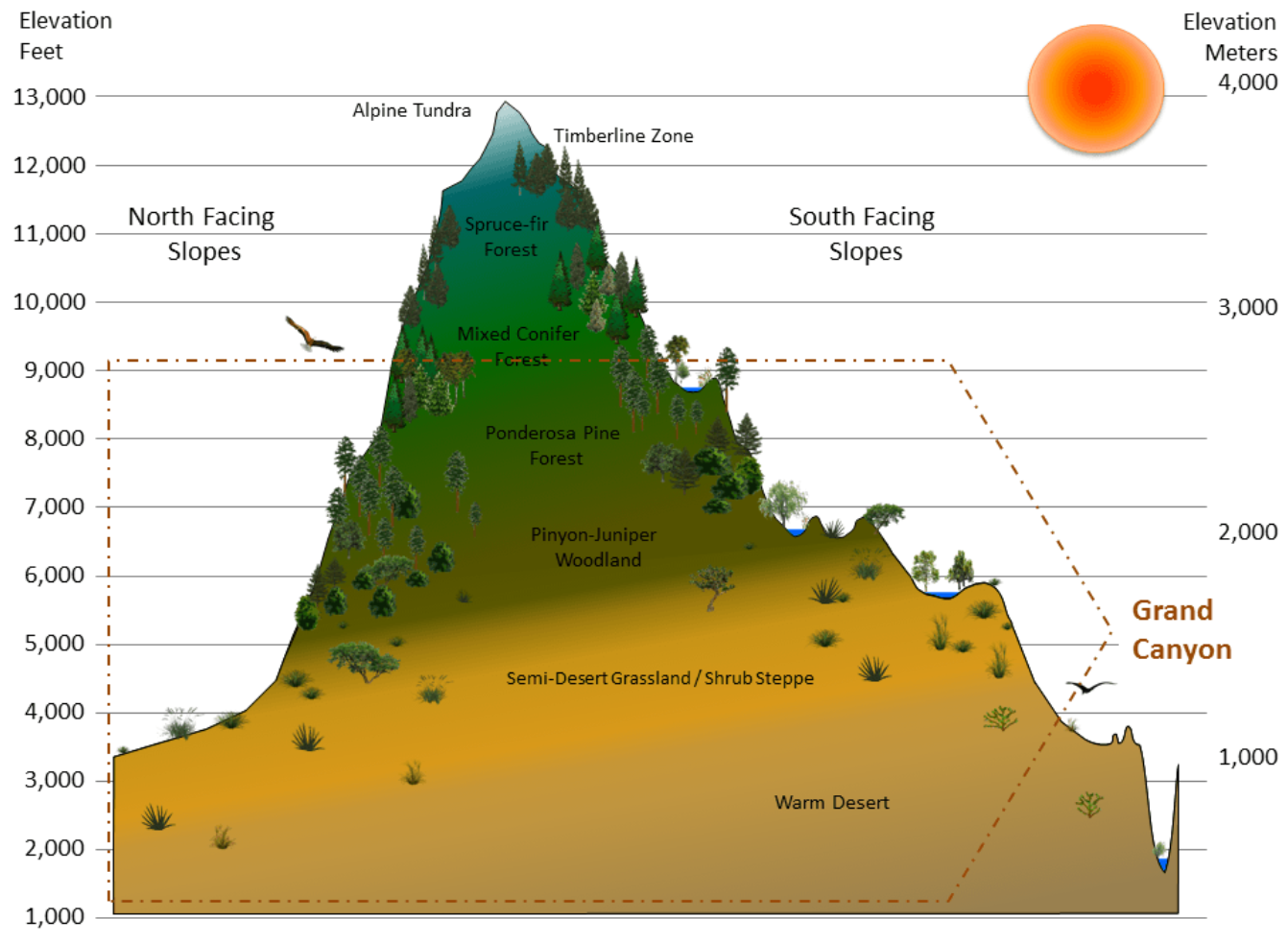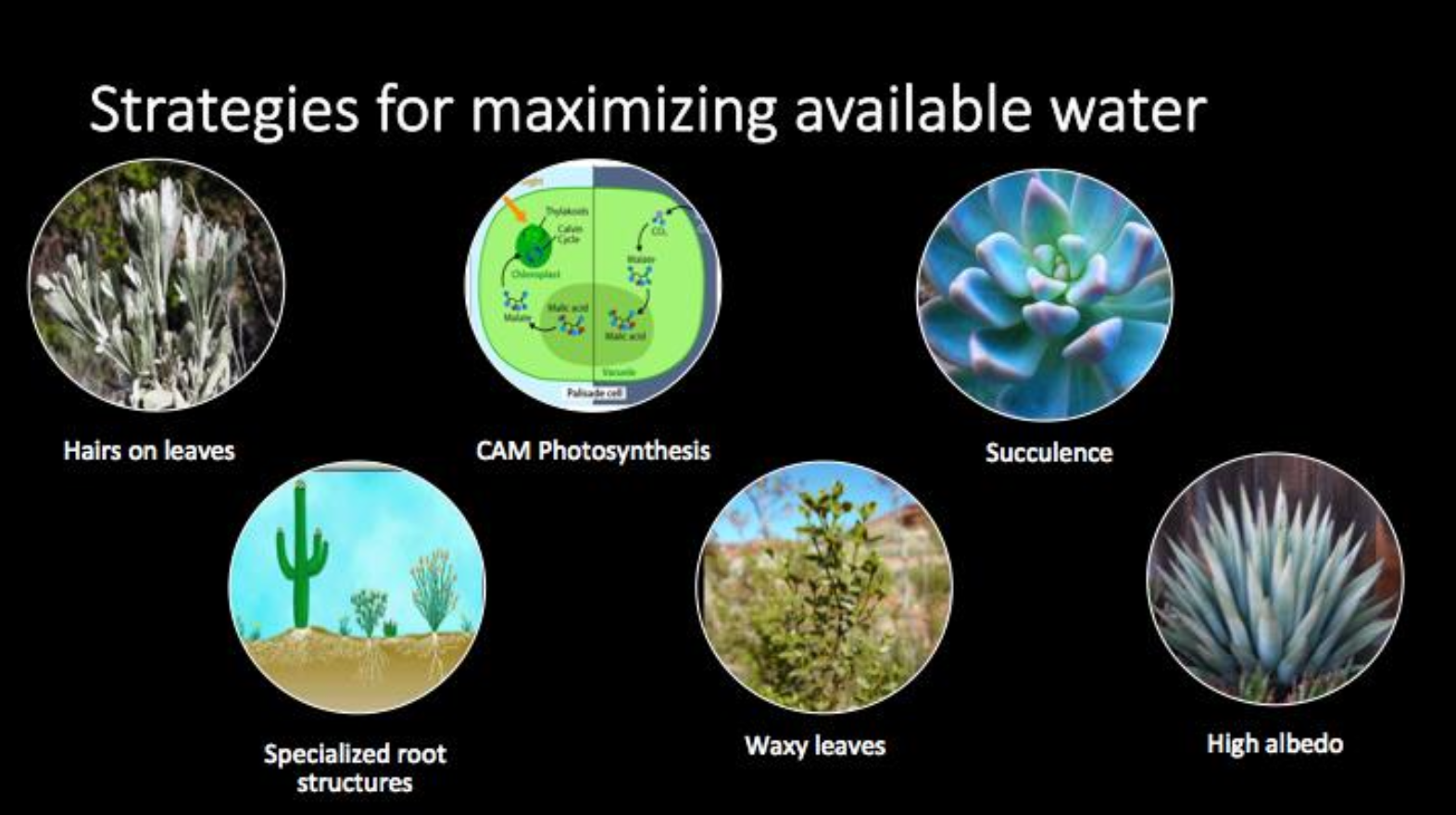Based on the presentation “Deserts of the Grand Canyon: Physiological and community level plant adaptations” by Rebecca Walker
Plants need two things in order to survive: sun and water. The harsh desert environment that makes up most of the land in the Grand Canyon National Park has an overabundance of sun, but lacks consistent rainfall. How do plants survive in such an unforgiving place? Why would plants live in a place where the sunlight is unrelenting, temperatures fluctuate greatly everyday, and rainfall comes in large unpredictable storms? Rebecca Walker, a graduate student in the ecology graduate group at UC Davis, explains the number of adjustments that plants make- both at the individual and at the community level- to survive in the desert.
Deserts are defined as regions where the amount of annual evaporation exceeds the amount of annual precipitation, resulting in water loss occurring at a faster rate than it can be replenished by rain events. In the Grand Canyon (Figure 1), this desert landscape occurs right above the zone that is directly affected by the river flow- resulting in a total of ~180 miles of desert vegetation!
Walker explains that desert plants have two options for survival when it comes to coping with unpredictable water availability. Some plants choose ephemerality- the “live fast, die young” approach- they grow and reproduce quickly following a rain event, taking full advantage of the available water. These plants are able to exist in a resistant, almost shell-like form in between rainstorms to conserve energy so they can go gangbusters when it finally does rain. The other option is that plants have a method for storing water so they collect water during rain events and keep it stored for use throughout the dry periods. These plants are deemed “drought tolerators” and utilize a number of different methods for storing water and reducing water loss. These methods, or adaptations, include: growing hairs on the surface of their leaves, using a different version of photosynthesis, succulence, growing long needle-like leaves, specialized roots, leaves with a waxy surface, or being light or pale colored (Figure 2).
Hair is not something you commonly think of when it comes to plants. The little hairs are almost invisible when you look at them, but some plants, sagebrush for example, are soft and relatively fluffy when you touch them. These hairs act like a windbreaker jacket for the plant, reducing water loss from the leaf surface.
All plants, by definition, convert sunlight to nutrients using a method called photosynthesis. Desert plants use a specialized type of photosynthesis (called CAM) that separates the night and day portions of the process. This means that the plants absorb the sunlight during the day while the sun is out, but they wait until night to open the stomata (pores in the leaves where gases are exchanged) to take in the carbon dioxide necessary to complete the reaction. Only opening their stomata at night reduces the amount of water that is lost by the plants to the air.
Succulents, plants like cacti and yucca, are representative desert plants, and are also popular as house or office plants due to their ability to survive with only sporadic watering. These plants are soft and spongy due to specialized cells that store water for future use. They also have a lower surface area to volume ratio resulting in reduced water loss.
The root systems of plants are mostly hidden and often overlooked by most until they impede progress while gardening or digging in the ground. For desert plants, there are two ideal root arrangements: a dense network hugging the top layer of the ground, or roots that go deep and tap the deepwater stores. The shallow and dense root system gives plants the ability to maximize their water acquisition following rain events with the hope of collecting enough to sustain themselves until the next rainfall. Deeper root systems instead allow plants to reach deeper water stores and reduce the need for plants to rely on rain events.
Though adaptations in appearance and behavior are essential for plants to survive, they can also work at a broader level to combat the harsh environment. Yes, that’s right, plants can use teamwork too! It is still disputed whether plants compete with one another for resources, or if the plants instead use their energy exclusively on finding water. Regardless of whether competition is present or not, it is recognized that some plants act as “nurse plants” for others. These “nurse plants” modify the environment in some way so that it is more suitable for other nearby plants. In the desert, these plants commonly provide shade, protection from the wind, and often provide nutrients for other plants. How these collaborative interactions develop is not well understood, but it is clear that teamwork is the key to success!
Between physical modifications and working together, plants have figured out how to not only live, but how to thrive in the harsh desert environment.


